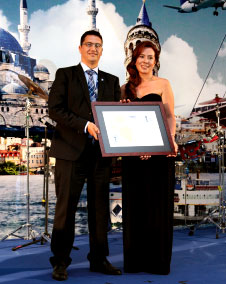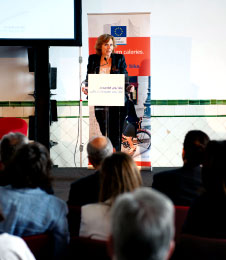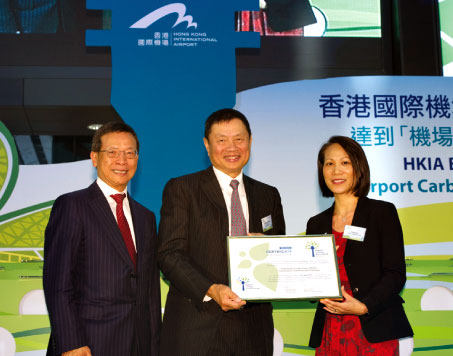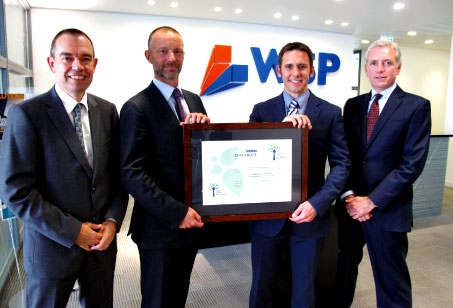
Pictured at the certification ceremony of Enfidha-Hammamet International Airport are Mr. Ali Tounsi (Secretary General, ACI AFRICA) presenting the “Mapping” certificate to Ms. Eda Bildiricioglu (Operations Services Manager, TAV).
The independent, institutionally endorsed programme, Airport Carbon Accreditation has already won praise from ICAO, UNEP and the EU’s Climate Action Commissioner Connie Hedegaard and Transport Commissioner Siim Kallas. It has also just achieved a place in the Top 10 shortlist of the EU’s World You Like Contest – an EU-wide competition for projects which help achieve a low carbon economy. The contest had 269 entrants and the final winners – selected from the Top 10 shortlist – will be announced at the gala evening of the Sustania conference taking place in Copenhagen in November.
Initially launched in Europe in June 2009, Airport Carbon Accreditation has moved up several gears in the past 4 years. In November 2011, the programme expanded to the Asia-Pacific region, gaining the support of ICAO at that time too. In June, at this year’s joint ACI EUROPE & ACI WORLD Annual Congress in Istanbul, the programme expanded again – this time to the African region of ACI. On that same night, Enfidha-Hammamet International Airport in Tunisia became the very first African airport to achieve certification.

Airport Carbon Accreditation has achieved a place in the Top 10 shortlist of the EU’s World You Like Contest. The contest had 269 entrants and the final winners will be announced at the Sustania conference in November.
Olivier Jankovec, Director General ACI EUROPE is delighted with the industry’s take-up of the programme. “Year 4 of Airport Carbon Accreditation was an epic year. We saw more airports reducing their CO2 than ever before, including an entire national airport group becoming carbon neutral. Our colleagues in Asia-Pacific secured the participation of 12 airports in Asia-Pacific, including Hong Kong International Airport, certified at the ‘Optimisation’ level. And now Year 5 has kicked off with the extension to Africa – that’s real momentum for such a young programme.”
Reducing carbon emissions
As the centrepoints of a complex web of aircraft movements, technical operations and surface access transport, airports can address their CO2 emissions in a variety of ways. These can include better insulation and energy efficiency, switching to green energy sources, investing in hybrid, electric or gas-powered service vehicles, encouraging employees, passengers & visitors to use public transport, working with airlines & air traffic management to reduce runway taxiing times and implement green landing processes, and much more.

Hong Kong Airport becomes the first airport in Asia-Pacific to achieve ‘Optimisation’ – Pictured at the certificate ceremony are Mr. Stanley Hui, CEO of Airport Authority Hong Kong; Dr. Marvin Cheung, Chairman of Airport Authority Hong Kong and Ms. Patti Chau, Regional Director, ACI Asia-Pacific.
As occurs every year in June, the programme’s Annual Report was released, with details of all the airports certified at one of the 4 available levels of certification (‘Mapping’, ‘Reduction’, ‘Optimisation’ and ‘Neutrality’). In Year 4 of the programme (June 2012 to May 2013), the collective reduction was over 170,000 tonnes of CO2, enough to power 71,000 households for a year.
Jankovec said: “This is concrete action that has produced effective, independently-verified results. Within and beyond Europe, airports of all sizes are now engaged in a real efficiency drive to reduce CO2 emissions that is making a tangible difference to the industry’s carbon footprint.”

TAG Farnborough Airport receiving their 'Optimisation' certificate, after the airport has successfully progressed up two levels within Airport Carbon Accreditation. (L to R) Simon Clouston, Global Director, WSP Environment & Energy (the programme administrator), Olivier Jankovec, Director General ACI EUROPE, Miles Thomas, Environment Manager and Brandon O'Reilly, CEO at TAG Farnborough Airport.
New entrants over the summer include Slovenia’s Ljubljana Airport and Bucharest Henri Coanda International Airport in Romania, as well as Adelaide, Parafield and Sunshine Coast airports in Australia (all certified at the ‘Mapping’ level). In terms of upgrades, Farnborough Airport in the UK recently succeeded in moving up another level, achieving the ‘Optimisation’ certification, as did Hyderabad Rajiv Ghandi International Airport in India.
Online application now available
For airports looking to apply to become Airport Carbon Accredited at one of the four available levels of certification, a new online application tool was launched in July, along with the programme’s new website. It eases the application process for airports and third party verifiers, as well as providing an intuitive and simplified process for renewals and upgrades. The new tool is aimed at making application more accessible, more cost effective and less time consuming for airports.
The new tool is an important development, not least because the programme requires voluntary application by each airport on an annual basis. In Europe, 77 airports in 24 countries are currently certified at one of the 4 available levels of accreditation, including 14 that are carbon neutral. Combined with the certification of 12 airports in the Asia-Pacific region of ACI and 1 airport in ACI Africa’s region, the programme now comprises 90 certified airports. These airports welcome around 22% of global air passenger traffic every year.







